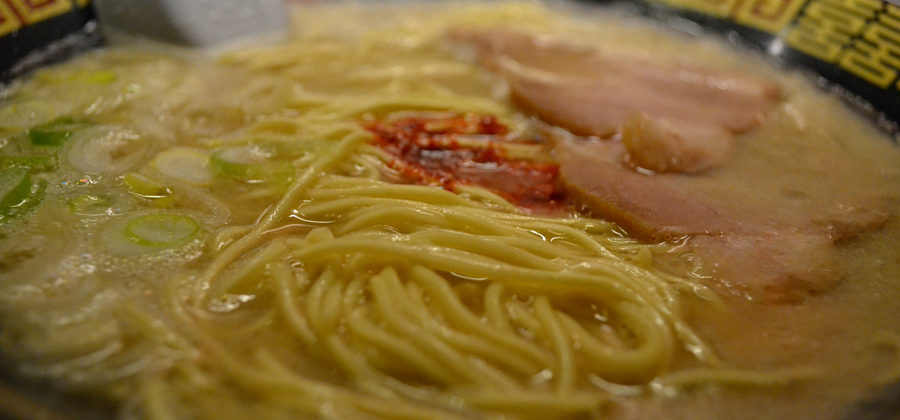As promised, I’m continuing my Ramen Madness series because I’m THAT passionate about Ramen. (Read part one here.)
This is a very special review because the Ramen in question, is not from Singapore. It is, in fact, in Japan: The birthplace of Ramen.
Just envision this:
It is a cold dark evening, we were walking along a street that is only lit by neon signs, and dim lamp posts. Hungry but, because we did the research, we were insistent to find a particular joint to eat and reserving all our stomach space for it. We only had a name, a rough address to go with, no pictures of the restaurant and a pathetic grasp of the Japanese language and basically hopelessly wandering around the streets of Hakata, Fukuoka.
After wandering around for 10 mins, I finally summoned my courage (and rummage the depths of my brain for what pathetic remains I can remember in my self-learnt Japanese language crash course just two months before this trip) and asked a friendly-looking Japanese young man: “Ichiran wa doko desu ka?” Which simply means, “Where is Ichiran?” He looked at me with, what I can best describe as a friendly “Duh” face and pointed up. Facing me was the huge words: ??. Oh!!! #facepalm I was in Japan after all, what did I expect? A signboard spelling out in English the word ICHIRAN??? So, after a hasty and embarrassed “Arigato” (and making a mental note to take note of the Japanese writing of restaurant/shop names in future when planning your own travel itinerary) we walked into the establishment… And were quickly stared down. Apparently, the first floor was for diners with families (think: rowdy children). It was VERY obvious that we were not local and the staff immediately directed us outside and up a flight of stairs and basically said “Go”. By now, we were feeling so helpless and bewildered that it felt like an eternity for us to complete the flight of stairs which was about three stories high.
Once at the top, you are greeted, rather coldly, by a machine. Not surprising in the land of vending machines, I suppose. At least, we were more comfortable with ordering from a machine than a real person because unlike a Japanese person, this came with English language… or rather “Engrish” which is the hilarious Japanese-style English.
After ordering (and giggling at the funny Engrish), we took our receipts and went in to find a seat. And that’s where you immediately sense the reality of all that I was reading about in other reviews kf Ichiran.
ICHIRAN is unique because of the way the Ramen is respected. Each customer sits in a little small (in Japan, this is normal sized) area on the counter that is partitioned like a cubicle. Facing you is just a wooden screen and some words. All this time, the only people you meet are other diners, intent on eating in silence. Sit down and after a short while, a mysterious hands pops in a slip of paper through the small gap at the back of the counter where you can select your order (again). Bad news. It was all in Japanese. After some muddling and low whispers with my husband, and not sure what to select because it was in all Japanese text, we pushed the paper back without filling anything. Surprise! A head suddenly popped up from the gap where the hand was!!! It was the first time I saw any waiters since I came in! He wondered why I didn’t fill in anything and, feeling stupid, I said I didn’t understand (Dewa arimasen). He eventually gave us an “Eigo” version.
I’m surprised by the simplicity of the options. Unlike Singapore’s joints where variety is key, ICHIRAN Ramen is unadulterated pure Tonkotsu Ramen. You only get to choose: 1. Hardness/Softness of your noodles, 2. Intensity of the soup (no chili) and 3. Some toppings.
It didn’t take long to be served a delicious hot bowl of Ramen. I ordered medium hard noodles and also the medium broth, plus some vegetables and a salted egg. Jonathan ordered medium hard noodles and the thickest broth.
The salted egg deserves a mention, because unlike the normal seasoned egg you get at other Ramen restaurants, this is just a semi-cooked cold egg with a wobbly center and you get a packet of salt to sprinkle on top. I do prefer seasoned egg inside the Ramen, but this isn’t bad!
After the first few slurps, a magical Ramen choir starts singing in your head. Because this is the only type of Ramen they create, it is certainly the best in its class. In ICHIRAN, silence is key so no matter how much you want to tell your partner how delicious it is, the best you can do is to enjoy the next scoop and give him a silly grin when you catch his eye. The idea is to take away everything that is distracting you from a d@^# good bowl of Tonkotsu Ramen.
All in all, although this experience was unusual and weird, it was not uncomfortably so for me, and in contrast, I found it extremely enjoyable.
When in Japan, you must embrace the differences in culture and even their peculiarities. Once in a while, it is great to just be one with the food for a change. You really get to taste the food and learn to break down the flavors in complete silence. You can taste nearly every single ingredient that goes into the broth, as well as delicious food. I did manage to sneak a bite from my husband’s thicker broth, and it was much thicker and more concentrated as expected.
There are many ICHIRAN outlets all over Japan. I had mine in Fukuoka, their place of origin. Next time when you are in Japan, be sure to try this unique dining experience for yourself! This is NOT the end of my Ramen reviews. For part three, I will review more delicious and popular Ramen that is available in Singapore.
Matane!







Leave a Reply